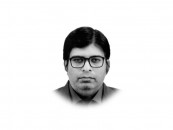The city that forgot to breathe
Lahore's smog crisis reflects deep systemic issues, requiring long-term, concrete actions to restore.

I grew up in a Lahore where the smell of fresh soil after a rainstorm was like a promise from the earth itself, where the intoxicating fragrance of raat ki rani drifted through open windows on balmy nights. Winter mornings were golden, the sun soft yet vibrant, inviting us to play cricket on sprawling lawns or in the lively streets of our neighborhoods. Back then, the air was a friend - crisp, clean and full of life.
Today, that Lahore feels like a distant dream. The golden winter sun has been swallowed by an impenetrable haze of smog, and the air stinks of neglect. The familiar joy of crisp mornings has been replaced by burning eyes, coughing lungs and a city gasping for breath. This isn't just a seasonal nuisance; it's a crisis that reveals systemic failures and misplaced priorities. Lahore has become a city where breathing itself feels like a hazard. Year after year, it consistently ranks as the most polluted city in the world on AQI, a dubious distinction that underscores the depth of our crisis. And while there are glimmers of hope in judicial actions and policy proposals, they are often overshadowed by the irony of how far we still are from meaningful solutions.
Recently, Justice Shahid Karim of the Lahore High Court stepped in with urgency and foresight, instructing transport authorities to develop a vehicle fitness policy within 15 days. Justice Karim also urged the government to draft a comprehensive ten-year policy to combat smog, signaling the need for long-term, sustained action rather than short-term fixes.
These are the kinds of measures Lahore desperately needs: systemic reforms that address the root causes of pollution. But the task at hand is monumental. The city's smog is not just about vehicle emissions; it is the culmination of unchecked industrial pollution, crop burning and urban sprawl that encroach on natural ecosystems. And while progressive judicial interventions are a start, they must be met with sincerity and action from all levels of government and society.
Yet, even as courts push for change, Pakistan's participation in global climate discourse sometimes feels like theater. The decision to send representatives from the Ravi Urban Development Authority (RUDA) to COP29 is a case in point. RUDA, whose ambitious plans to urbanise the Ravi River have drawn widespread criticism for their environmental consequences, was tasked with speaking about sustainability. The irony here stinks almost as much as the smog enveloping Lahore's skies.
This disconnect between rhetoric and reality is at the heart of Lahore's environmental crisis. Imagine a Lahore that chooses a different path - embracing innovative solutions and respecting its natural heritage. Clean air corridors could replace traffic-clogged roads, using solar-powered air purifiers to scrub the air while promoting pedestrian and electric vehicle traffic. Rooftops could be transformed into green sanctuaries, cooling the city and absorbing carbon. Precision agriculture technologies could help farmers manage crop residues without resorting to burning, turning fields of ash into opportunities for innovation.
Justice Karim's call for a ten-year policy is an invitation to imagine such a future. For this vision to become reality, we must move beyond symbolic gestures and commit to concrete, sustained action. Policies must be implemented with urgency, transparency and accountability, ensuring they do not languish in bureaucratic inertia. Our actions at home must align with the promises we make on global platforms. Most importantly, we must recognise this crisis not as a temporary inconvenience but as an existential threat to our health, economy, and the generations yet to come.
Lahore is a city with a rich past and a resilient spirit, but it is at a crossroads. The smog crisis is a test of our collective will. Will we continue down the path of concrete jungles and toxic air, or will we fight for the Lahore that once was, the city of Gardens - and could be again? By 2034, Lahore could become a model of urban resilience, with clean air corridors, green rooftops, and electric tuk-tuks humming through its streets. But this vision will only be possible if we stop treating environmental advocacy as a performance and start treating it as a mission.














COMMENTS
Comments are moderated and generally will be posted if they are on-topic and not abusive.
For more information, please see our Comments FAQ